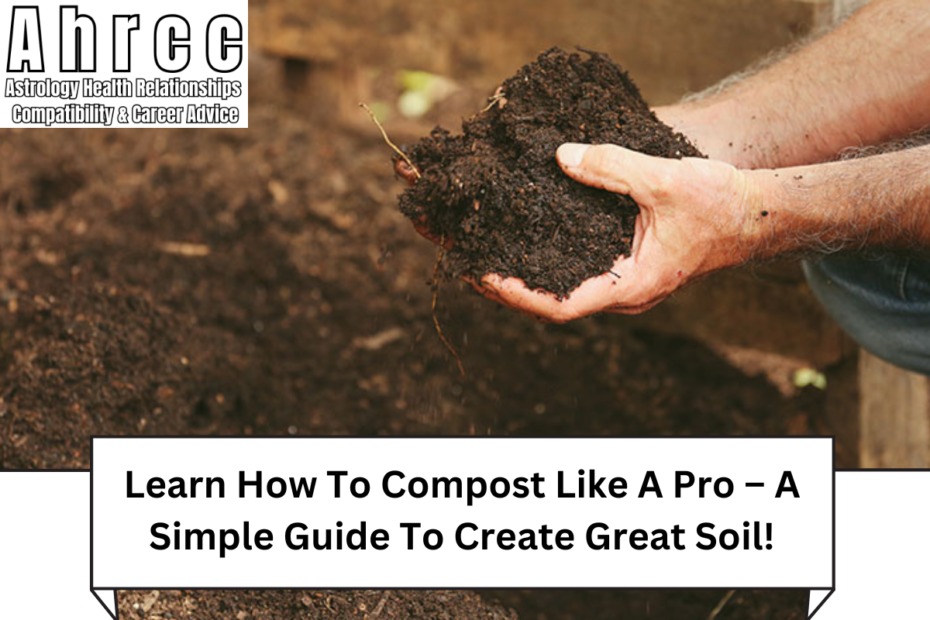Learn How To Compost Like A Pro – A Simple Guide To Create Great Soil!: Composting is an eco-friendly way to recycle organic waste and turn it into nutrient-rich soil that can improve your garden. Whether you’re a beginner or someone who wants to take their composting game to the next level, learning the basics of composting will help you create high-quality compost like a pro.
Not only does composting reduce the amount of waste sent to landfills, but it also helps your plants thrive by enriching the soil with essential nutrients.
In this guide, we’ll walk you through simple steps to compost like a pro, explain the key elements involved, and share tips to make the process faster and more effective.
1. Understand the Basics of Composting
Composting is the process of breaking down organic materials like food scraps, leaves, and yard waste into a dark, crumbly substance called humus. This humus is full of nutrients that can boost plant growth. To compost effectively, you need to balance four main elements:
- Green materials (nitrogen-rich): Kitchen scraps, coffee grounds, grass clippings, and fresh plant trimmings.
- Brown materials (carbon-rich): Dried leaves, straw, cardboard, paper, and wood chips.
- Water: Moisture is necessary to keep the composting process going.
- Air: Aeration through turning helps supply oxygen to microorganisms that break down the materials.
A good balance of green and brown materials is key to creating great compost. Aim for roughly three parts brown to one part green for the best results.
2. Choosing a Composting Method
There are a few different ways to compost depending on your available space and lifestyle. Here are three popular methods:
Compost Pile
A compost pile is ideal if you have a large backyard. Start by layering brown and green materials in a pile directly on the ground. Turn the pile regularly to aerate it and help speed up the decomposition process.
Compost Bin
A compost bin keeps your compost contained and is perfect for smaller spaces. You can purchase one or make your own by converting a large plastic or wooden bin. The bin should have air holes or slats to allow airflow.
Vermicomposting
If you’re tight on space or want to compost indoors, consider vermicomposting, which uses worms to break down food scraps. Worm bins can be kept under the sink or in small areas, and the worms produce nutrient-rich compost called castings.
3. What Can (and Can’t) Be Composted
Knowing what materials to add to your compost is crucial to maintaining a healthy balance and avoiding bad odors or pests. Here’s a quick guide:
Compostable Materials
- Vegetable and fruit scraps
- Coffee grounds and filters
- Eggshells (crushed)
- Yard waste like grass clippings and leaves
- Paper and cardboard (shredded)
- Tea bags and tea leaves
Avoid Adding
- Meat, dairy, and bones (these attract pests and take longer to decompose)
- Oily foods or grease
- Diseased plants or weeds that have gone to seed
- Pet waste (it can contain harmful bacteria)
By sticking to compost-friendly materials, you’ll ensure that your compost is safe, nutrient-rich, and free of unpleasant smells.
Also see:How To Create Gorgeous Container Plants From Perennials – For Free!
4. Maintaining Your Compost Pile
Once you’ve started your compost pile or bin, it’s important to maintain it so that the materials break down efficiently.
Keep It Moist, But Not Wet
Your compost pile should have the consistency of a damp sponge. If it gets too dry, decomposition will slow down. Water the pile occasionally, but if it becomes too wet, add more brown materials to absorb the excess moisture.
Turn the Pile
Turning your compost regularly helps introduce oxygen, which speeds up decomposition. Use a garden fork or shovel to turn the compost once every one to two weeks.
Monitor the Temperature
If your compost pile is active and healthy, the internal temperature should rise to between 120-160°F. This heat is a sign that microorganisms are working hard to break down the materials. If the pile cools down, it may need more green materials or moisture.
5. When Is Compost Ready?
The composting process can take anywhere from two months to a year, depending on the method and the materials used. You’ll know your compost is ready when:
- It’s dark, crumbly, and has an earthy smell.
- The original materials, like food scraps and leaves, are no longer recognizable.
Once your compost is ready, you can use it in several ways to improve your garden. Mix it into garden beds to enrich the soil, use it as mulch to retain moisture, or sprinkle it on top of the lawn as a natural fertilizer.
Conclusion
Composting is an easy, eco-friendly way to turn everyday waste into valuable garden soil. By balancing green and brown materials, maintaining the right moisture and air levels, and regularly turning your pile, you can create high-quality compost like a pro.
Whether you’re using a simple backyard pile or an indoor vermicomposting bin, the results are worth the effort. Your plants will thank you for the nutrient-rich soil, and you’ll feel good knowing you’re reducing waste and contributing to a more sustainable world.
